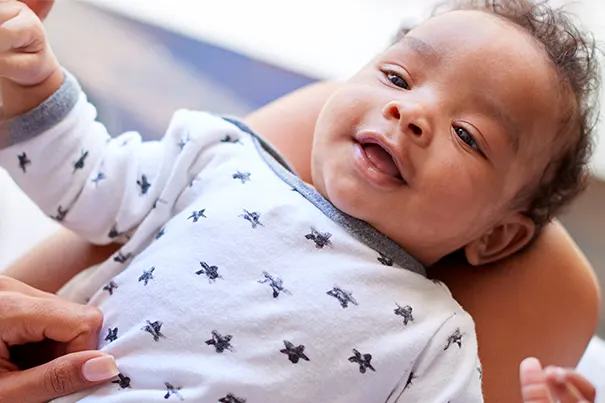Pampers Diapers and Wipes: common questions
Learn more about Pampers' commitment to safety in the following frequently asked questions and answers. If you have additional questions, please don't hesitate to contact us.
Q: Why is my baby's diaper leaking?
A: Because babies come in all different shapes and sizes, diapers fit babies differently. At Pampers, we measure thousands of babies' legs, bottoms and waists to try to get a good fit that helps contain leaks. Sometimes leaks happen because the leg cuff or waist is a bit folded. Running your finger around the waist band and cuffs sometimes helps to ensure a better fit. Another reason for leaks is if there isn't enough absorbent material for the baby's urine output. If your baby is close to the upper end of the weight range of the diaper you're currently using, you may want to try the next diaper size up, as there is more absorbent material in the larger diapers.
Q: Are all of the ingredients in Pampers safe for babies?
A: Pampers diapers, wipes and pants are made from ingredients that are thoroughly tested and proven to be safe. The ingredients we use are common in most diapers and wipes and are used safely by millions of babies around the world every day.
Q: What causes diaper rash?
A: Unfortunately, diaper rash is very common. More than half of babies between the ages of 4 months and 15 months develop diaper rash, and nearly all babies will get at least one diaper rash before they are potty-trained. Changing the diaper promptly after it becomes wet or soiled is the best way to prevent diaper rash. For more about the causes and treatment of diaper rash.
Q: Do Pampers cause diaper rash?
A: There are no ingredients in Pampers that cause diaper rash, and studies have shown that modern super-absorbent disposable diapers may actually provide benefits for your baby by improving skin health. For more about how to avoid and treat diaper rash, please read our article about diaper rash .
Q: What are the gel beads inside Pampers and are they safe if I find them on my baby's skin?
A: This super-absorbent gel is commonly used in disposable diapers and in the packaging of many food products. These small gel beads absorb nearly 30 times their weight, to help lock moisture away from your baby's skin. Occasionally, you may see some of these gel beads on your baby's skin. They are safe and can be gently wiped away. To learn more about what's in a diaper, read our article about diaper ingredients.
Q: Are the colourful designs on Pampers safe for my baby's skin?
A: Yes. All of our colours have been carefully evaluated for safety and have been proven safe for infants and children. They are non-allergenic and skin-safe. They are also commonly used in other consumer products, contact lenses and food packaging.
Q: When you make changes to Pampers diapers, do you safety test them first?
A: Whenever we make changes to Pampers, we only use ingredients that are already safely used in our diapers or that have been thoroughly evaluated and proven safe. We also conduct extensive testing to allow moms to experience our products in real-life situations, and we adhere to the highest industry standards for safety, performance and quality.
This video, from one of our Pampers researchers and moms, explains more about how we design diapers to meet the needs of babies and their parents – and to meet the highest safety standards.
Q: Are there chemicals in Pampers that can cause chemical burn?
A: No. Pampers diapers, wipes and training pants are made from ingredients that are thoroughly tested and proven to be safe. The ingredients we use are common in most diapers and wipes, and have been used safely by millions of babies around the world. Visit this page to learn more about the ingredients in our diapers.
Q: Do Pampers Baby wipes or diapers contain the ingredients methylisothiazolinone or methylchloroisothiazolinone (also known as Neolone, Kathon, MI, MCI)?
A: No. Pampers Baby Wipes and diapers do not contain methylisothiazolinone or methylchloroisothiazolinone.
Q: Are Pampers Baby Wipes gentle for babies' sensitive skin?
A: Yes. Pampers Baby Wipes have been clinically tested to ensure they do not cause allergies or skin irritation and are clinically proven to be mild even on sensitive skin. In fact, Pampers Baby Wipes are milder than a flannel and water.
Q: Are Pampers Baby wipes safe to use on my baby's face and hands?
A: Yes. While specifically designed for diaper change clean-up, moms can be assured that Pampers wipes are safe for use on other body parts – including the face – and can be used at every diaper change.
Q: What's better for my baby: disposable diapers or cloth diapers?
A: Today's disposable diapers have a decades-long history of safe use by many millions of babies. Studies have shown that modern super-absorbent disposable diapers may actually provide benefits for your baby by improving skin health.* In addition, today's disposable diapers have been proven to reduce excess skin wetness using super-absorbent gel that locks in urine and keeps moisture away from the baby's skin, helping to reduce incidences of diaper rash.
As an industry leader in innovation, Pampers is dedicated to creating better, more efficient products that offer noticeable benefits while reducing the environmental footprint of our products and packaging. A major independent study by the United Kingdom's Environment Agency in 2005 and updated in 2008 showed that neither disposable nor cloth diapers were better for the environment. The study considered all parts of each diaper's lifecycle: to make, distribute, use and dispose of the products. This extensive UK study found that the environmental impacts of diapers are actually linked to the energy, water and detergents needed to clean reusable diapers, and to the raw material production for disposable diapers. By considering the overall lifecycle of both products, the study confirms that there is little to no difference in environmental impact between cloth and disposable diapers.
*(Adam, Ralf. 'Skin care of the diaper area.' Paediatric dermatology 25.4 (2008): 427-433; Seymour, Jon L., et al. 'Clinical effects of diaper types on the skin of normal infants and infants with atopic dermatitis.' Journal of the American Academy of Dermatology 17.6 (1987): 988-997).

